The three engined Do-24K is the icon of the Dutch Naval Air Service in the far East. I decided to dedicate this page of my blog the valiant men who flew these unique planes and who fought and died in those terrible early months of 1942…
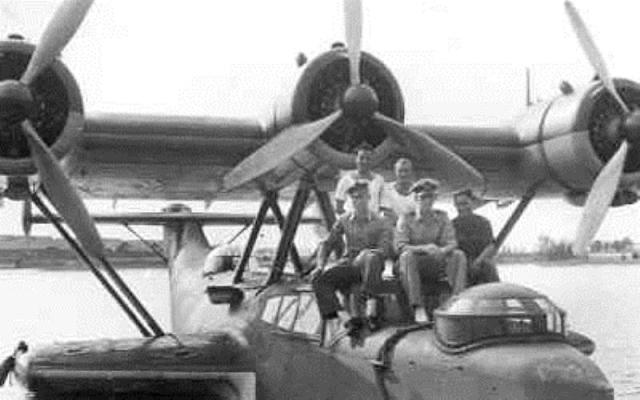
A Dutch Do-24K Crew photographed at Morokrembangan in 1941 (Source Royal Dutch Navy)
Procurement history.
By 1934 the Dutch Naval Air Service (MLD) was scanning the market for a possible successor to their ageing fleet of Dornier “Wal” (Whale) flying boats. These airplanes had been in service since 1928 and were fast becoming obsolete. The MLD was looking for a replacement that would have the same reliability and rugged seaworthiness the Wal offered but with a much improved performance.
A MLD delegation had a good look at Dornier’s newest design for a transatlantic mailplane, the Do-18. It retained the layout of the Wal but was aerodynamically and hydrodynamically more efficient. Its boat shaped metal hull had the distinctive stabilizing sponsons (called “Stummel” in German) that did away with the need for wingtip floats. And it was powered by two engines on top of a parasol wing in an unusual push-pull configuration.
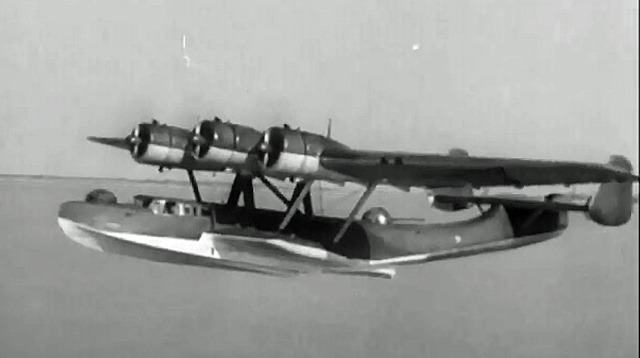
A Dutch Do-24K in wartime camouflage (source: Royal Dutch Navy)
The MLD delegation liked what it saw but was not satisfied. The choice of Junkers Jumo 205 diesel engines raised questions (the engines were not even available yet) as did various other points, such as range and payload. A junior MLD officer, 2nd Lt. C. Sanders, wrote a specification based on the Do-18 design. This spec did away with the pusher prop arrangement, asked for three conventional engines (no diesels) of a type in general use, a top speed of 315 km/h (175 Mph) and sufficient range for operations in the vast Dutch East Indies. This specification was sent to Dornier and a number of other companies.
Dornier was able to produce a mock-up and a tentative production schedule of what they called the P.14 by the end of 1935. The only competitors left at that time were Fokker and Sikorsky. Their designs were rejected and on August 6, 1936 the Dutch Navy signed an initial contract for six Do-24’s.
Dornier ran into production difficulties as soon as the contract was signed. Germany was re-arming at a large scale and the Reichs Luftfahrt Ministerium (Ministry of Aviation) did not allow any domestic production capability to be diverted towards export orders. After some head-scratching Dornier came up with a solution. Orders would be handled through their Swiss subsidiary Aero-Metall A.G. in Zurich and construction would take place at A.G. für Dornier Flugzeuge in Altenrhein, on the Swiss side of the Bodensee (opposite Dornier’s main plant in Friedrichshafen).
The German Luftwaffe was also interested in the Jumo 205 equipped version of the Do-24 but delivery of the engines was delayed. Erich Gundermann took the third prototype (Do-24V3) equipped with Wright Cyclone GR-1820-F52’s up for the first ever test flight of a Do-24 on July 3rd 1937. Next day it was officially handed over to the MLD for acceptance trials. Registered as D-ADLP, it was flown on September 5, 1937 to Weser Flugzeugwerke at Einswarden (at the mouth of the Weser river, opposite Bremerhafen in Germany). From this base the prototype was subjected to seaworthiness trials on the North Sea.
By the end of October 1937 the MLD happily accepted the prototype, impressed as it was with the Do-24V3’s performance (during rough water trials its cockpit roof was completely submerged at times). The machine was given the MLD serial “X-1” and was shipped on November 10, 1937 from Hamburg to Morokrembangan, the main MLD base on Java (near Surabaya). The remaining 5 Do-24K’s were quickly delivered between January and March 1938 with the exception of the X-4; this was the first of the series to have Dutch electronics installed and was flown to Holland on May 18, 1938 by Erich Gundermann and Dutch Naval pilot J.W.F. Backer.
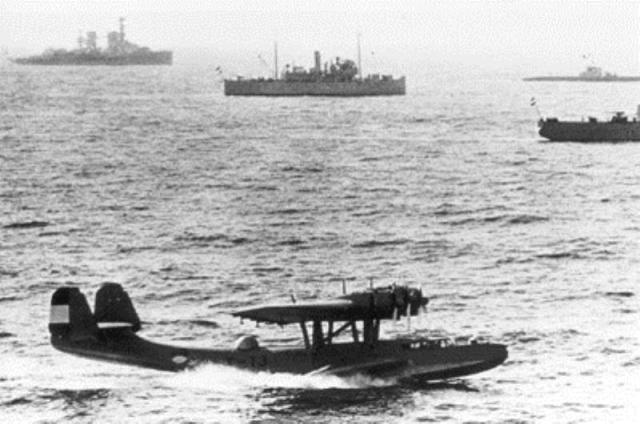
Do-24K “X-4” during a Naval Pageant off the Scheveningen Coast, September 3 1938 (Source Royal Dutch Navy)
The Dutch navy had a far-sighted view on political and military developments. The Navy top had concluded that a major conflict with Japan was unavoidable. To defend the vast Indonesian archipelago against a Japanese invasion, a strategy was devised that consisted of flying boats and submersibles operating jointly, backed up by conventional fleet units.
Specialised submarines were designed and built (The “K” series, adapted for shallow water operations) and 66 additional Do-24’s were required to support this strategy. As early as July 22, 1937, 12 Dorniers were ordered, followed by 6 more on May 30, 1938 and 5 on January 13, 1939.
Knowing the Germans would never consent to have the flying boats built in one of their factories, the Dutch government negotiated a license production agreement. The aircraft should be built by the “Aviolanda” company, a joint venture between Dornier and Burgerhout’s Shipyard in Papendrecht near Rotterdam. This company had been set up in the mid-1920’s to produce the Dornier “Wal”and so circumvent the Versailles treaty ban on German aircraft production.
Operational experience with the Do-24K1 soon led to some design modifications, most important of which were a switch to Wright Cyclone GR-1820-G105A engines, a demand for increased fuel capacity and the addition of bomb racks. Designated Do-24K2, this model was to be produced in The Netherlands with Fokker and other companies as subcontractors for components.
The Dutch navy knew it would take time for Dornier to re-engineer the K2 series and for Aviolanda to tool up and hire and train metalworkers. Therefore, the Dutch Navy ordered an ‘interim’ batch of 24 K1’s to be built by Dornier. A first K2 (as a “hands-on” training model) was ordered in February 1939. And a batch of 24 K2’s was ordered later in 1939 with deliveries to be completed before July 1, 1940.
Construction of the first “Aviolanda” K1 (MLD serial X-30) started on June 15, 1938 but took a year to complete it. The delays were primarily caused by communications problems with Dornier. And the situation was aggravated when the war broke out in 1939, skilled personnel was drafted into the Dutch armed forces and there was a shortage of building materials. Therefore, when the German forces invaded the low countries on May 10, 1940, only 7 K1’s had been delivered by Aviolanda.
Operational history
At the start of the Pacific War, the MLD had 73 modern flying boats in service, including both operational aircraft and spares. This was almost double the combined British and American total. These 37 Dornier Do24-K (“X”-boats) and 36 PBY-5 (“Y”- boats) were organized into 18 flights of three aircraft.
Their major base was at Naval Air Station Morokrembangan, near Surabaya in eastern Java. The MLD had secondary bases as well as seaplane tenders that enabled it to spread out and cover the entire Netherlands East Indies.
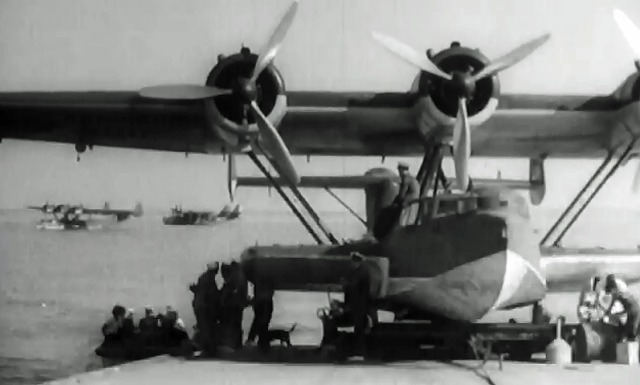
A Do-24K on the Morokrembangan slipway, mid 1941 (Source Royal Dutch Navy)
MLD “X”- Boat Order of Battle – December 7, 1941:
| GVT-1 | 3 Do-24 | Pontianak | West Borneo | |
| GVT-2 | 3 Do-24 | Sorong | New Guinea | (1) |
| GVT-3 | 3 Do-24 | Surabaya | Java | (2) |
| GVT-4 | 3 Do-24 | Sambas | West Borneo | |
| GVT-5 | 3 Do-24 | Ternate | Moluccas | |
| GVT-6 | 3 Do-24 | Surabaya | Java | |
| GVT-7 | 3 Do-24 | Tarakan | East Borneo | (3) |
| GVT-8 | 3 Do-24 | Paelo Sambu | Sumatra |
- Destroyed 1941-12-26. Reactivated 1942-1-19 with 3 PBY-5 Catalina at Padang.
- Reserve squadron. Re-equipped with 3 PBY-5 Catalina on 1942-1-16.
- Re-equipped with 3 PBY-5 Catalina on 1942-1-12
As soon as the war broke out, the Dutch sent a flight of three “X”-Boats to Seletar airbase Singapore, early December 1941 and also gave the British three spare PBYs. Two other flights of Dorniers based in northwest Borneo were also detailed to cover the seas off Malaysia.
For most of the campaign for Malaysia, the Philippines and Indonesia, the Allied fleets would rely on the MLD’s flying boats as their “eyes in the sky”, carrying out reconnaissance, anti-submarine patrols and convoy escort. The Dutch “X”-Boats were armed with twin-gun turrets in nose and tail, a formidable Oerlikon 20mm cannon amidships, and under-wing bomb racks capable of carrying 3,000 lbs of bombs.
The first engagement between Dutch and Japanese forces of the Pacific War occurred on 13 December 1941 when Dornier X-22 shot down a Mitsubishi G3M “Nell” bomber with its 20mm cannon.
December 16 saw what may have been the first ever dogfight between two flying boats, Dornier X-30 versus a Kawanishi H6K “Mavis”. The X-30 hit the “Mavis” starboard inboard engine, but return fire knocked out the X-30s centre engine and its electrics. The crippled Dutch plane then successfully withdrew. On December 17, off the coast of Miri, Borneo, X-32 sank a Japanese destroyer, DD Shinonome, with the loss of all 228 on board. Another inconclusive fight occurred December 20 between a pair each of Dornier and Mavis flying boats. On that same day, the X-35 successfully directed the Dutch sub K-XIV into a Japanese invasion flotilla off Kuching. The submarine sank or damaged four transports. This was a type of operation the MLD had specifically trained for before the war.
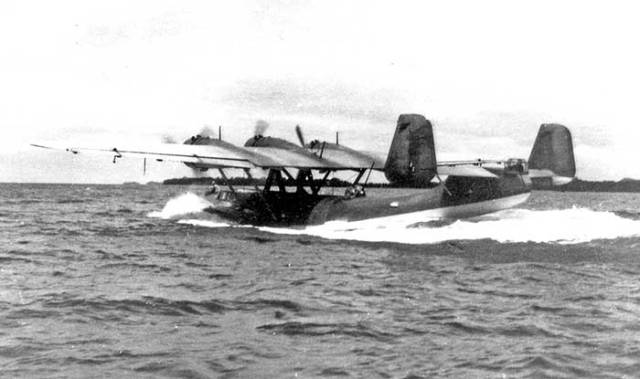
MLD Do-24K taking off . Date unknown. (Source Royal Dutch Navy)
But the losses also began. On 23 December X-27 was shot down during a six plane attack on Japanese shipping at Davao, Philippines. On December 26, four Dorniers were destroyed at their moorings at Lake Tondano (Sumatra) by Japanese fighters.
With the formation of the ABDA central command in early January 1942, the Dutch effectively lost control of their long-range squadrons. All reconnaissance squadrons were put under a central command called Rec-Group. Dutch pre-war doctrine of air-naval co-operation was supplanted by a kind of central clearing house for information gathered by the reconnaissance aircraft. Language, doctrine and differing command styles led to disastrous backlogs, and the Allied surface forces effectively sailed into combat blind.
Dutch Admiral Helfrich said that, where an air-to-ship message before the war would take no more than 10 minutes, under the new command structure, it could take up to six hours, making the information hopelessly out of date.
By the middle of January 1942, Dutch flying boats were again being used as a long-range strike force. For a couple of weeks, the force had been conserved for reconnaissance duties, but the Allies had few other aircraft with the range and hitting power of the flying boats. Another vital duty of the flying boats throughout the campaign was the sea rescue of air and naval crew from destroyed aircraft or sinking ships.
Between January 19 and 22, 1942, the MLD made repeated raids against the Japanese at Kuching (Borneo), but by the end of that month, the MLD had been largely driven back to Java. Altogether, the MLD lost eight flying boats in December and five in January, but the really catastrophic losses would come in February. Between February 8 and 25, nine Japanese air raids devastated the main MLD base at Morokrembangan, near Surabaya. once the largest and most well-equipped naval base in the world.
The MLD scattered its flying boats across the interior of Java using rivers and small lakes. And yet, in spite of mounting losses on the ground and in the air, the MLD mounted daily reconnaissance and air-to-sea rescue missions, saving hundreds of Allied sailors.
RAAF Service
Five of the older Dorniers (X-5, X7, X-8, X-9 and X-10) were “transferred to Australia” on February 19, 1942 as part of a planned evacuation of the MLD training school to a safe location. These five Dorniers formed up at RAAF Rathmines in March to continue MLD crew training before being taken over by the Royal Australian Air Force.
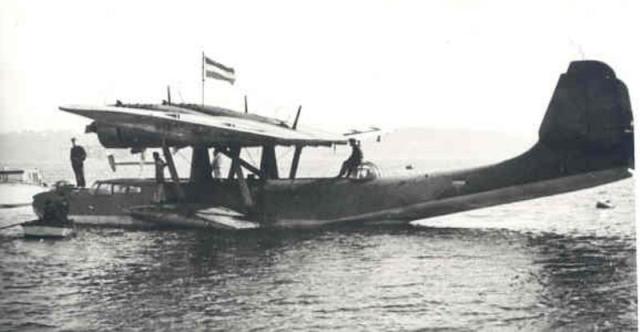
Do-24K at Rose Bay, Sydney – Date unknown (Geoff Goodall Collection)
Later in February 1942, MLD Dornier and Catalinas were regular arrivals on Roebuck Bay at Broome, quite a few arrived crammed with up to 30 civil and military personnel fleeing the NEI. The final disaster came on March 3, 1942 when Japanese fighters attacked Broome. Five “X” boats and four Catalinas were destroyed with an official loss of life stated 73 (but probably much higher…)
The five training machines sent to Australia in February were joined by a sixth (X-24) evacuated later in March 1942
According to ADF Serials “…all the Dornier’s were in poor condition and required several months of repairs and modifications after reaching Australia. The aircraft were given RAAF Serials A49-1 thru A49-6 consecutively. One of the machines (A49-6) served the majority of its remaining career with the Netherlands Forces Intelligence Service flying between Australia and the NEI, while the other five (A49-1 thru A49-5) served with No 41 Maritime Transport Squadron based in Townsville, Queensland. Maintaining the aircraft proved to be very difficult as spares were virtually non-existent because the aircraft arrived without support equipment, servicing manuals or tools…’
The RAAF retired the “X”- boats in 1944.
Overview MLD “X” boats (updated June 24, 2016)
| Serial | c/n | Delivered | Fate/Notes |
| X-1 | 761 | 03-Jul-37 | Strafed / burned 3 Mar 1942 near Broome |
| X-2 | 762 | Jan-38 | Accident 24 Apr 1941 near Morokrembangan, NEI |
| X-3 | 763 | Jan-38 | Strafed / Burned 3 Mar 1942 at Broome |
| X-4 | 764 | 14-Mar-38 | Accident 13 Nov 1941 near Morokrembangan, NEI |
| X-5 | 765 | 18-Mar-38 | Handed over to RAAF 29 Apr 1942, to A49-1 |
| X-6 | 766 | Mar-38 | Bombed / destroyed 3 Feb 1942 at Morokrembangan, NEI |
| X-7 | 767 | 04-May-38 | Handed over to RAAF 29 Apr 1942, to A49-2 |
| X-8 | 768 | May-38 | Handed over to RAAF 29 Apr 1942, to A49-3 |
| X-9 | 769 | May-38 | Handed over to RAAF 29 Apr 1942, to A49-4 |
| X-10 | 770 | 14-Jul-38 | Handed over to RAAF 29 Apr 1942, to A49-5 |
| X-11 | 771 | 19-Jul-38 | Strafed / Burned 26 Dec 1941, LakeTondano (North Celebes) |
| X-12 | 772 | 08-Sep-38 | Strafed / Burned 26 Dec 1941,Lake Tondano (North Celebes) |
| X-13 | 773 | 01-Sep-38 | Lost near Roti 7 Feb 1942 |
| X-14 | 774 | 1938 | Crash landed 22 Jan 1942, Sungai Riko river (Balikpapan) |
| X-15 | 775 | 1938 | Missing 29 Dec 1941, Karimata Straits, S. China Sea |
| X-16 | 776 | 1938 | Bombed / Destroyed at Tandjong Priok, 1 Mar 1942 |
| X-17 | 777 | Dec-38 | Shot down near Noordwachter 25 Feb 1942 |
| X-18 | 778 | 16-Jan-39 | Shot down near Noordwachter 24 Feb 1942 |
| X-19 | 779 | 31-Jan-39 | Crash, 24 Jan 1942, rice paddy near Fort Menari, Java |
| X-20 | 780 | 14-Feb-39 | Strafed / burned 3 Mar 1942 near Broome |
| X-21 | 781 | 03-Mar-39 | Missing 24 Jan 1942 after mine-laying flight near Bali |
| X-22 | 783 | 20-Mar-39 | SOC 8 Jan 1942 at Morokrembangan |
| X-23 | 784 | 21-Apr-39 | Strafed / burned 3 Mar 1942 near Broome |
| X-24 | 785 | 05-May-39 | Handed over to RAAF Oct 1943, to A49-6 |
| X-25 | 695 | 24-May-39 | Strafed / burned 26 Dec 1941, LakeTondano (North Celebes) |
| X-26 | 696 | 07-Jun-39 | Strafed / burned 26 Dec 1941, LakeTondano (North Celebes) |
| X-27 | 697 | 18-Jul-39 | Forced landing near Taruna 23 Dec 1941 |
| X-28 | 698 | 23-Aug-39 | Strafed / burned 3 Mar 1942 near Broome |
| X-29 | 699 | 25-Sep-39 | Crashed 11 Feb 1942 near Morokrembangan |
| X-30 | 67 | 07-Jul-39 | Bombed / Destroyed Morokrembangan 3 Feb 1942 |
| X-31 | 68 | 29-Aug-39 | Bombed / Destroyed Morokrembangan 5 Feb 1942 |
| X-32 | 69 | 28-Sep-39 | Sunk near Roti 7 Feb 1942 |
| X-33 | 70 | 20-Nov-39 | Bombed / Destroyed Morokrembangan 5 Feb 1942 |
| X-34 | 71 | 11-Dec-39 | Forced landing North Borneo 17 Dec 1941 |
| X-35 | 72 | 06-Mar-40 | Burned near Koepang (Roti) 8 Feb 1942 |
| X-36 | 73 | 08-Mar-40 | Destroyed 3 Mar 1942 Broome |
| X-37 | 700 | 06-Dec-39 | Bombed / Destroyed Morokrembangan 3 Feb 1942 |
| (Note: X-37 was ex X-30, upgraded to D0-24K2) |
